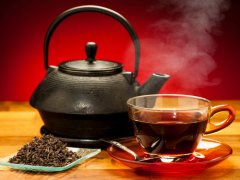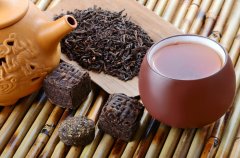The tea is very bitter. Why is it? There is a kind of tea. What kind of tea is sweet after drinking it?
Tea and wine have a lot in common. High-quality examples are identified by the environmental specialization of a variety or a single plant species. Both depend on soil factors, including soil quality and climate, to form an ideal flavor. Both require skilled craftsmanship and attention to detail to meet the high standards of connoisseurs.
Although the final product is very different, there are similarities between the taste quality and the way the last cup is judged. Although each taste is very different, bitterness and astringency are often cited in the tasting records of these two flavors, with hidden words about the overall quality of the final product.
These two characteristics are closely related and are often confused, especially for inexperienced tasters. However, they come from completely different molecular compounds in wine and tea. So how do experts distinguish between these different flavor ingredients? What effect do they have on the quality of tea?
Bitter taste
Sensitivity to bitterness is one of the five main flavors that prevented our ancestors who hunted and gathered wild fruits from ingesting toxic substances. In tea, bitterness is also used as a natural pest deterrent to protect plants from common insects. Some of the bitter compounds in tea are thought to be methylxanthine, such as caffeine, and other ingredients.
Tea leaves naturally produce more bitter compounds and are more vulnerable to pests, including those that grow large in summer, or in warm climates near sea level. Whole leaves release bitterness much more slowly than sweet, floral or fresh volatile substances in our mouths, but leaves that are cut into small pieces release bitterness faster.
Much of the long history of tea cultivation and consumption has revolved around reducing the bitterness in the cup, from planting tea gardens at high elevations to selecting tender leaves in early spring to specific brewing methods such as those used in Kungfu Tea. In general, strong bitterness is considered a sign of shoddy tea, or milk and sugar are added after brewing to counteract the bitterness in the tea.

Astringent taste
Astringency is not a taste perceived by the taste buds, but actually a dry feeling in the mouth. As a result, it is not limited to the sensation on the tongue, but also on the cheeks and throat, and is built up during a drink and increases with each sip. For this reason, experienced tea drinkers (and wine connoisseurs) usually prefer astringency because it prolongs the duration of the taste. In tea, the taste that remains for a long time after being swallowed is called aftertaste or sweet taste, and is highly valued.
In addition, astringency is usually attributed to tea polyphenols, including catechins, which have been studied on the antioxidant properties of tea. These molecules come from amino acids exposed to sunlight, which means that tea that absorbs more sunlight has more amino acids and is therefore more astringent.
This may overlap with the conditions that lead to bitterness, such as low altitude and summer harvest, which helps to explain the link between the two characteristics. But astringency can also be accompanied by strong flavors, such as oolong tea in the Phoenix Mountains, which grows in ancient groves.
There are many different types of polyphenols in tea. One of the most common and frequently studied types is flavanols, sometimes called tannic acid. Tannins are found in most plants, including grape skins, and are generally considered to be the main source of astringency. Tea and wine can lead to dry mouth and a long aftertaste, which is generally considered to be high in tannins.
In short, for some types of tea, astringency is not only the taste that everyone pursues, but even needs and deliberately makes it astringent. By contrast, bitterness is usually a sign of mass production and is rarely associated with high-quality tea. Wine drinkers may not be surprised.
Is your tea sweet and smooth, or is it a bit bitter?
Important Notice :
前街咖啡 FrontStreet Coffee has moved to new addredd:
FrontStreet Coffee Address: 315,Donghua East Road,GuangZhou
Tel:020 38364473
- Prev

How to look at black tea? How to choose black tea the method of distinguishing the advantages and disadvantages of black tea is explained in detail
The importance of quality I am not saying that all tea workers in China are in a similar ideal state, at least when most tea production still focuses on price competitiveness rather than quality advantage. However, as more consumers begin to understand and demand quality, producers will be under pressure to learn to reward workers for better skills. It is not through the artificial setting up of third-party supervision.
- Next

What is the reason for the bitter tea? What does tea have? What kind of tea sets are used for each of the six kinds of tea
With so many different tea styles and culturally unique brewing customs around the world, it's hard to know what equipment is best for making your favorite tea. In fact, most pots can brew almost any kind of tea. But just as geographical isolation led to the development of many different tea styles, it also created parallel developments for tea sets. Many teas complement the tea sets of nearby areas
Related
- The milk tea cup becomes smaller?! Overlord Tea Girl launches a new "Return to Yunnan" series
- Accused of selling counterfeit and high-priced coffee beans! Well-known boutique coffee brand "Oukelao" bowed and apologized!
- How to make espresso dumplings? Can I eat coffee and glutinous rice balls together?
- Save the unformed and stagnant powder cakes in one second! What is the problem with stagnant water in the powder bowl of the espresso machine?
- What does hand-brewed coffee stop mean? Why is it not recommended to make coffee by hand?
- Is it normal to smell like coffee? Why does coffee smell like alcohol? What's wrong with the strong smell of cold extract ice dripping ice brewed coffee?
- How to solve the problem that hand-brewed coffee extraction takes too long? Why is the water flowing so slowly when making coffee?
- The main points of making Australian white coffee, the proportion details, how does Australian white properly foam and blend the flowers?
- Can ice water make cold extract coffee? What is the difference between room temperature water and ice water for making cold coffee?
- What milk is best for making latte and white Dirty coffee? What is the difference between different brands of fresh milk and pure milk for making coffee?

